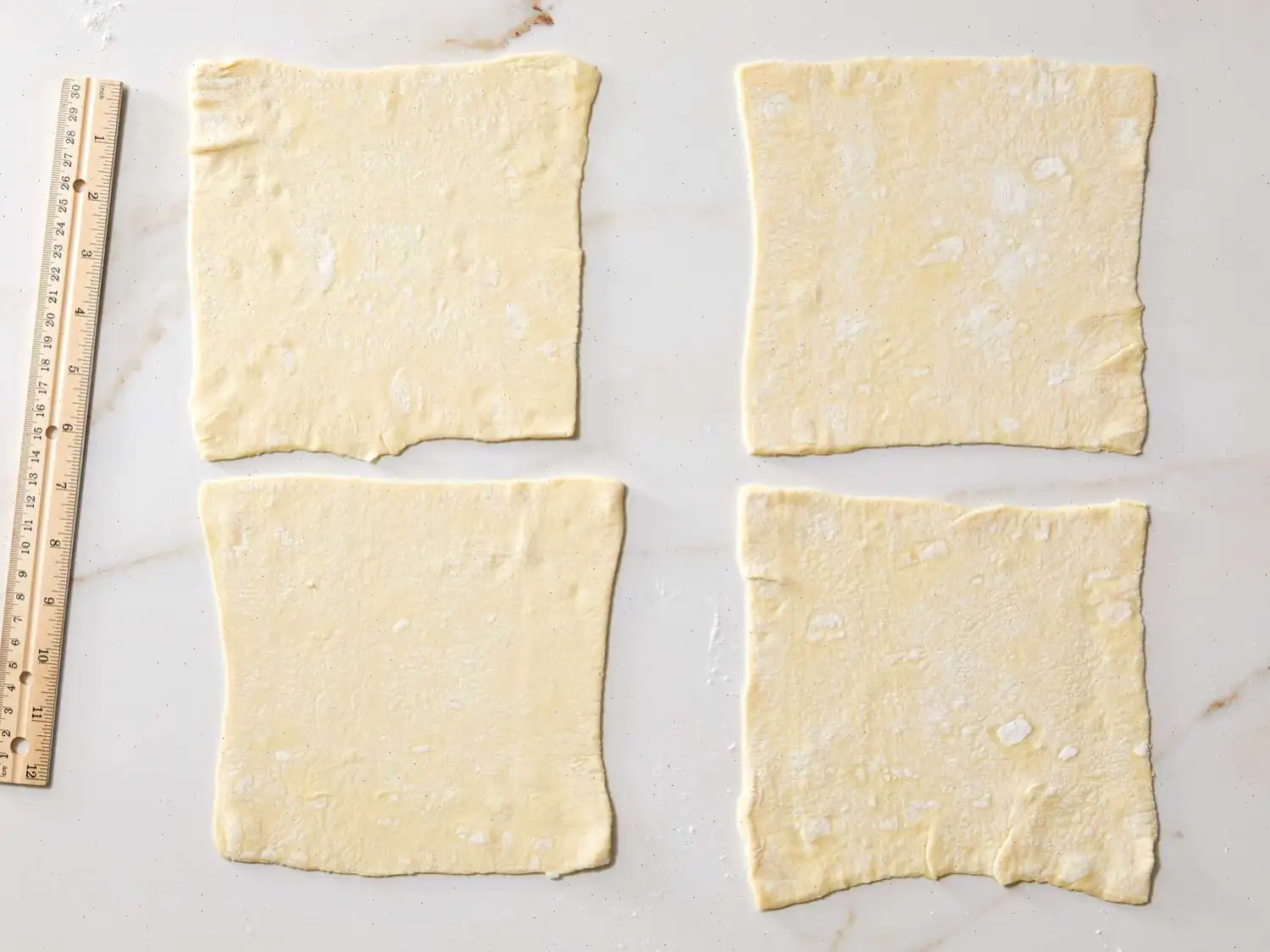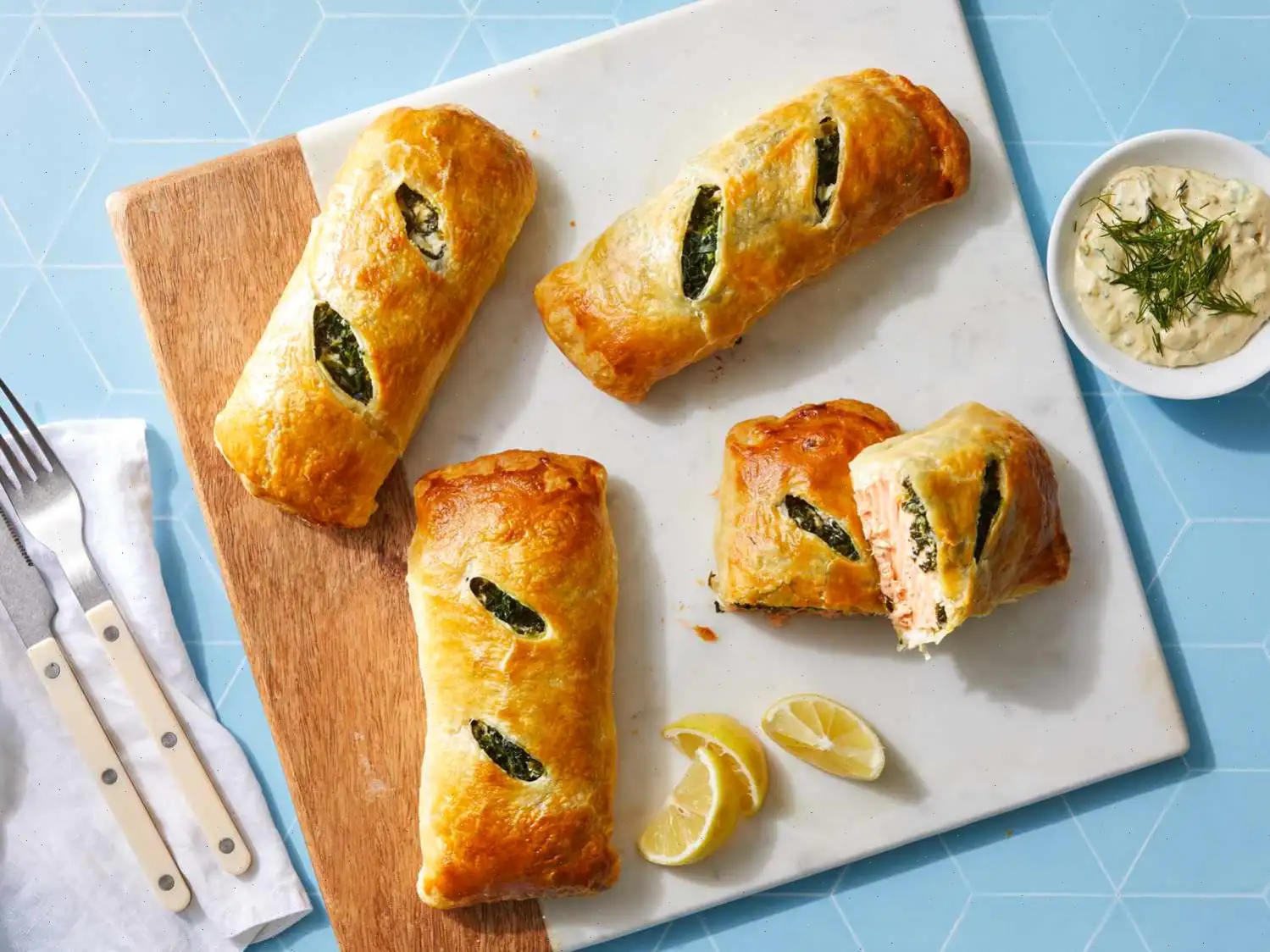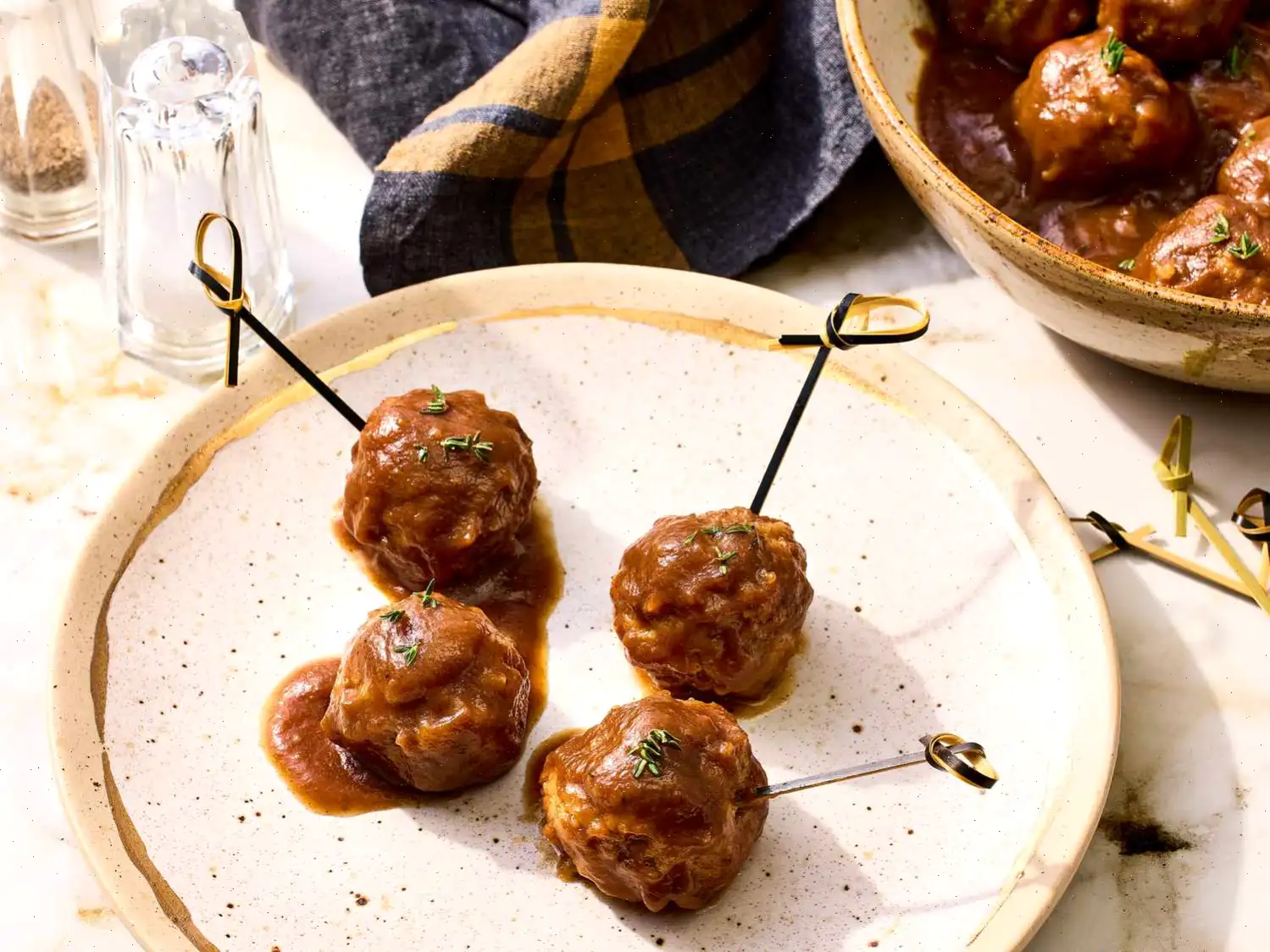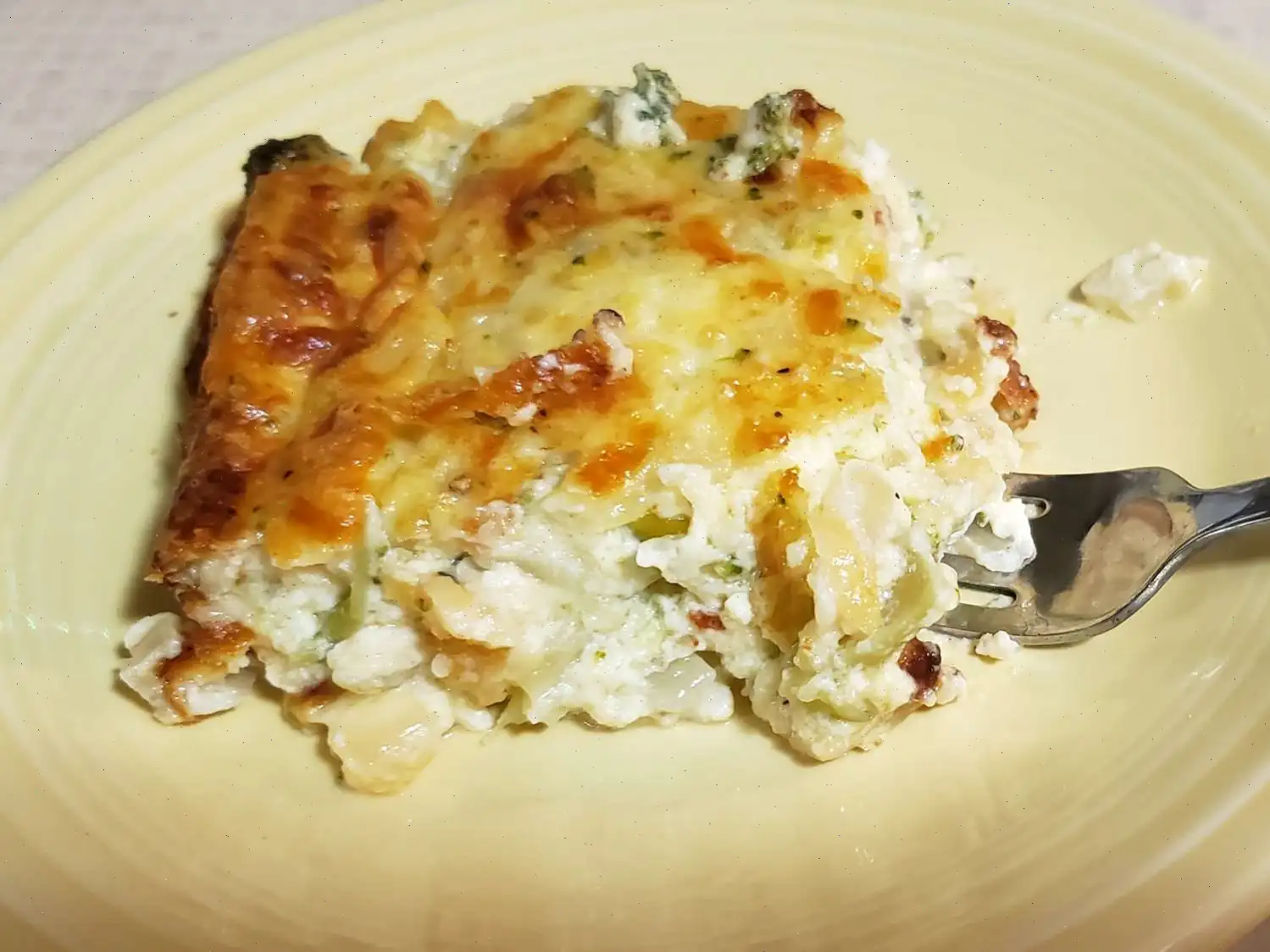
Individual Salmon Wellingtons Recipe
Ingredients
- 1/2 teaspoon kosher salt
- 1/2 teaspoon ground black pepper
- 4 (6-ounce) skinless salmon fillets
- 1/2 cup mayonnaise
- 1/4 cup Dijon mustard
- 2 teaspoons chopped fresh oregano
- 2 teaspoons chopped fresh basil
- 2 teaspoons chopped fresh dill weed
- 2 teaspoons lemon zest
- 1 teaspoon chopped fresh thyme
- 1/2 cup crumbled feta cheese
- 1/2 (10-ounce) package frozen chopped spinach, thawed and drained
- 1 frozen puff pastry sheet, thawed
- 1 egg
- 1 tablespoon water
- Lemon wedges (for serving)
Directions
Step 1: Preheat your oven to 400F (200C) and line a baking sheet with parchment paper. Set aside.
Step 2: Pat the salmon fillets dry with paper towels, then season both sides with salt and pepper.
Step 3: In a small bowl, combine mayonnaise, Dijon mustard, chopped oregano, basil, dill, lemon zest, and thyme. Set aside half of the mixture for serving.
Step 4: Spread the remaining herb-mayo mixture generously on top of the salmon fillets.
Step 5: Sprinkle crumbled feta cheese over the salmon, followed by a layer of chopped spinach.
Step 6: Cut the puff pastry sheet into quarters. On a lightly floured surface, roll each portion into a 7x7-inch square.
Step 7: Place each salmon fillet (with the topping side down) in the center of a pastry square.
Step 8: Fold the edges of the pastry over the salmon, pinching the edges to seal. Place each salmon bundle, seam-side down, on the prepared baking sheet.
Step 9: In a small bowl, beat together the egg and water to create an egg wash. Brush the egg wash over the tops and sides of the pastry bundles.
Step 10: Cut several small slits in the tops of each pastry bundle to allow steam to escape while baking.
Step 11: Bake in the preheated oven for 20 to 25 minutes, or until the pastry is golden brown and crispy.
Step 12: Serve the Salmon Wellington with the reserved herb-Dijon mixture and fresh lemon wedges on the side.
Nutrition Facts (per serving)
- Calories: 715
- Fat: 51g (65% Daily Value)
- Saturated Fat: 11g (55% Daily Value)
- Cholesterol: 182mg (61% Daily Value)
- Sodium: 1084mg (47% Daily Value)
- Total Carbohydrate: 23g (8% Daily Value)
- Dietary Fiber: 7g (24% Daily Value)
- Total Sugars: 6g
- Protein: 46g (93% Daily Value)
- Vitamin C: 102mg (114% Daily Value)
- Calcium: 249mg (19% Daily Value)
- Iron: 4mg (23% Daily Value)
- Potassium: 1168mg (25% Daily Value)
* Percent Daily Values are based on a 2,000-calorie diet. Your daily values may be higher or lower depending on your calorie needs.
** Nutrient information is based on available data for all ingredients. If you're following a medically restrictive diet, please consult with a healthcare provider or dietitian before preparing this recipe.
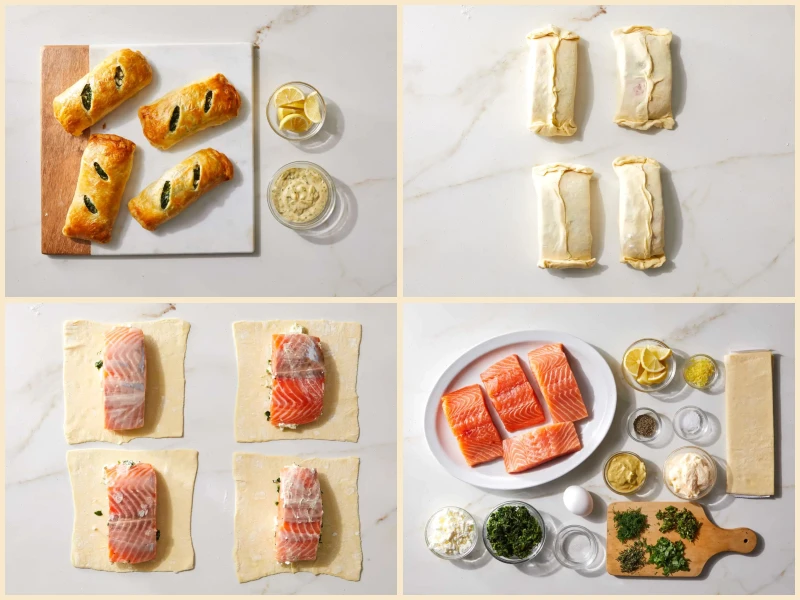
The History of Salmon Wellington
Salmon Wellington is a refined twist on the classic Beef Wellington, which dates back to early 19th-century England. The original Beef Wellington was designed to showcase premium cuts of meat encased in delicate puff pastry, often with a mushroom duxelles and sometimes pt. As culinary traditions evolved and seafood became more celebrated in haute cuisine, chefs began substituting beef with salmon, creating a lighter, more elegant alternative that retained the luxurious presentation of its predecessor. This adaptation gained popularity in both European and North American fine dining circles during the late 20th century.
Regional Variations
While Salmon Wellington is widely enjoyed internationally, certain regions have added unique touches. In North America, chefs often incorporate cream cheese or Dijon mustard in the filling to enhance richness and flavor, while Mediterranean versions may include spinach, feta, and fresh herbs such as oregano and dill. In Scandinavian countries, smoked salmon variations are common, emphasizing local preservation techniques and subtly smoky flavors. These regional interpretations highlight how local ingredients and culinary preferences influence this versatile dish.
Differences from Similar Dishes
Salmon Wellington differs from similar seafood pastries in several key ways. Unlike standard salmon en crote, which typically features plain puff pastry wrapped around fish with minimal seasoning, Salmon Wellington often includes a layered filling of herbs, spinach, and sometimes cheese, offering complexity in both taste and texture. Compared to traditional Beef Wellington, salmon versions are lighter, cook more quickly, and emphasize freshness and moistness rather than the robust richness of beef.
Serving Occasions
Salmon Wellington is typically served as a main course during special occasions, holiday dinners, or celebratory events. Its elegant presentation makes it a favorite for dinner parties and restaurant menus. Often accompanied by a simple green salad, roasted vegetables, or a lemon-herb sauce, it balances sophistication with approachable flavors, making it equally suitable for formal and semi-formal gatherings.
Interesting Facts
- The name Wellington is believed to honor the Duke of Wellington, famed for his military victories, symbolizing triumph and refinement in cuisine.
- Individual salmon portions make this dish convenient for modern plating and personalized servings, compared to a single large Wellington traditionally shared.
- Using puff pastry allows the salmon to stay moist while providing a crisp, golden exterior, creating a contrast that is both visually appealing and texturally satisfying.
- Herb combinations like dill, thyme, and basil enhance the natural flavor of salmon without overwhelming it, showcasing the versatility of fresh ingredients in gourmet cooking.
- Salmon Wellington can be easily adapted for seasonal variations, incorporating ingredients such as mushrooms, asparagus, or leeks, reflecting both creativity and regional produce availability.
You can listen to this recipe in AI audio format. Simply click the play button below to listen to the content in a format that suits you best. It’s a great way to absorb information on the go!
FAQ about Individual Salmon Wellingtons Recipe
Comments
Scott Martin
02/23/2025 08:53:44 PM
I usually don't like feta, but I decided to experiment with it in this spinach filling. The dish turned out to be surprisingly delicious without relying on the usual onion-garlic combination. I believe the secret ingredient was the mayo/mustard/lemon spread. I had some leftovers and added freshly sliced cucumber, which made it even more enjoyable. I will definitely be making this dinner again!









